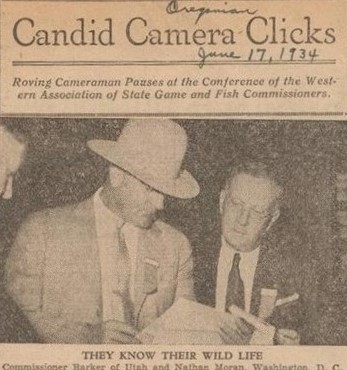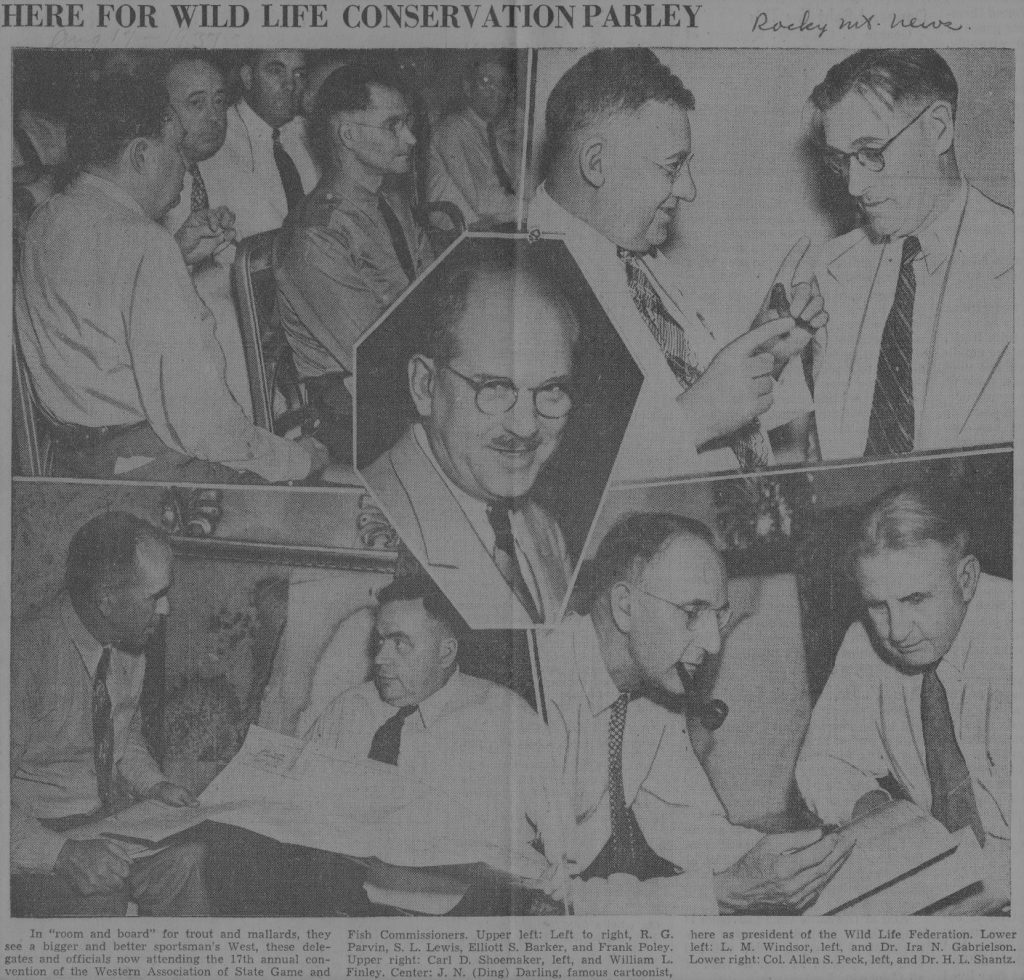Continuing the 100-Year Legacy of Advocacy for Scientific Fish and Wildlife Management and Cooperative Conservation in the West
Western Association of State Game Commissioners 1921 – 1929
In the 1920’s, game commissions throughout the West were just beginning to assume their responsible positions with respect to the management of game and fisheries resources. Of particular importance was a threat to state sovereignty in the matter of game management by the growing federal land management agencies. These federal agencies were similarly undergoing a period of growth and were in the process of carving out areas of responsibility which many people believed included the management of game on the vast areas of federal lands in the west. The developing states, feeling that the matter of state sovereignty was paramount, banded together for mutual assistance and protection against what was thought at that time to be a federal push leading toward the management of all wild land resources in these states.
In 1922 visionary managers formed the precursor of today’s WAFWA
In 1922, several “pioneers” from the western states’ game departments met in Salt Lake City to form the Western Association of State Game Commissioners to combat this threat. The important players in this early movement were Dave Madsen of Utah, C. A. Jakways of Montana, A. E. (Cap) Burghduff of Oregon, and Rolly Parvin of Colorado. Seven game officials from some of the western states sat around a table in Dave Madsen’s office in the State Capitol in Salt Lake City to form the first meeting of this Association. Madsen was elected President of the Association in 1922 to be followed by Jakways in 1923, Burghduff in 1924, and Parvin in 1925. The early bylaws provided that membership should consist of the game commissioners or state game wardens of the states of Montana, Wyoming, Colorado, New Mexico, Nevada, Utah, Idaho, Arizona, California, Oregon, and Washington. In those days, fish and wildlife agencies were called “commissions”, although few had a separate commission as we know it today.
Objectives of the original organization were to promote harmony and unity among its members and members of like associations throughout the country for the purpose of exercising a combined and powerful influence in securing the enactment of laws and amendments; to present laws favoring the propagation of wildlife and fish; and to further provide for just, reasonable, and uniform laws and regulations for the protection of wildlife and fish.

Western Association of Fish and Wildlife Agencies
1950s. As member agencies began to alter their structure, so too did the Western Association. In 1957, the name was changed to the Western Association of State Game and Fish Commissioners to reflect the growing emphasis on fisheries programs. In 1978, the name was again altered to reflect changing times. As member agencies became “departments” rather than “commissions”, the Western Association evolved to its current name, the Western Association of Fish and Wildlife Agencies (WAFWA).
1970s. While these early accomplishments were significant, a series of actions undertaken by the Western Association since the late-1970s has established its reputation for innovation and leadership.
Project WILD
The first of these came in 1979, when in an effort to counter the growing urbanization of our society with the lessening of the public’s awareness of fish and wildlife issues, the WAFWA began development of a wildlife education program designed to be used by school teachers in the classroom. Member agencies provided personnel and financial support for the development of classroom activities and teaching aids and funded the implementation stages. The product, known as Project WILD, exploded onto the scene, capturing the imagination of teachers and helping shape state wildlife agency conservation education programs.
Today, Project WILD is approaching its 45th anniversary as an interdisciplinary, supplementary environmental and conservation education program for educators of kindergarten through high school age young people. Nearly a million educators have been trained in Project WILD workshops and they, in turn, have provided instruction to more than 48 million youth. Project WILD is literally, today, a worldwide phenomenon. The WAFWA relinquished Project WILD to the Association of Fish and Wildlife Agencies, but remains very committed to its purpose. Visit PROJECT WILD
Responsive Management
In 1985, the Western Association began developing another program designed to help fish and wildlife agencies become more responsive to conflicting user and public demands on the natural resources.
This program, called Response Management, incorporated survey techniques to provide information on public attitudes and opinions in order to tailor management programs. Originally it included a training program especially directed toward fish and wildlife agencies dealing with conflict resolution, marketing and managing change. Agencies quickly began using Responsive Management techniques to improve agency image and performance. Again, because of the rapid rate of expansion, the WAFWA transitioned out of its direct program management responsibilities for Responsive Management in the mid-1990s.
Today, Responsive Management, Inc., under the leadership of Mark Duda, has blossomed into one of the premiere natural resource firms in the country. This program, started in the West, has left its mark on agencies and vastly improved our collective knowledge and understanding of our constituencies. Visit RESPONSIVE MANAGMENT
CITES
In 1997, the U.S. Fish and Wildlife Service (USFWS) and the Association of Fish & Wildlife Agencies (AFWA) outlined a regional system of representation to ensure that all the states would have a voice in the Convention on International Trade in Endangered Species (CITES) and the USFWS would not be dealing individually with a large state contingent on international matters. This approach would enable representatives of the state fish and wildlife agencies (CITES Technical Work Group) to fully participate.
WAFWA’s regional representation on this working group has helped provide biological expertise (directly or through species experts within the states) and strengthen the US position internationally while assuring states’ positions are made known. For example, during the 23rd Animals Committee in 2008, the Humane Society unsuccessfully attempted to have black bear, river otter, and sandhill crane included in significant trade review. With input from the CITES Technical Work Group concerning state wildlife agency management, population status assessment, and harvest regulations, the three species were dropped from consideration. Visit AFWA’s CITES Technical Work Group
MOUs
Starting in 1999, WAFWA again set precedence with Memorandums of Understanding (MOUs) among member agencies involving the conservation and management of such species as the black-tailed prairie dog, Townsend’s Big-eared bat and sage grouse. These multi-state, rangewide initiatives, led by WAFWA, are putting into place plans, protocol, and habitat standards that should allow these species from being listed under the Endangered Species Act. More importantly, they will enhance the status of these populations throughout their range.
Accompanying these efforts have been WAFWA-driven university research on genetics, rangewide conservation assessments and strategies, and MOUs with federal agencies aimed at bringing about meaningful change on the landscape. An example of success from this approach is BLM’s launching of its Sage Grouse Habitat Conservation Strategy designed to support the states’ sage grouse conservation plans and maintain sage grouse habitats in the West. Strategic positioning by WAFWA directors has helped shape national policy and the arena in which the states must operate today.
Human Dimensions
Finally, within the past several years, the Western Association has become very aggressive in the human dimensions arena and funded the first-of-its-kind pilot research project concerning public values toward wildlife in the West. The study examined the relationships among societal and lifestyle characteristics, wildlife value orientations, and attitudes toward specific wildlife management actions. The initial study only involved six western states. Based on the results, the study was expanded to include wildlife values among people in all 19 western states. This pioneering work, performed by researchers at Colorado State University (CSU), is having profound benefits to all member agencies because in addition to individual state-specific data, the regional component of the survey provides the basis for comparison between member states, and across the region.
As a product of this effort, since 2007 WAFWA has offered a Human Dimensions Certification Program through CSU for wildlife professionals. View this Opportunity.
This same approach was later employed to learn more about public attitudes regarding chronic wasting disease. Another regionwide survey was recently conducted to answer questions concerning people’s perspectives about the disease which, in turn, has helped fashion agency programs designed to deal with these findings. View HUMAN DIMENSIONS COMMITTEE
While capturing some of the highlights of the past ten decades of the Western Association of Fish and Wildlife Agencies, it doesn’t do justice to the hard work and issues confronted by the thousands of directors, commissioners and professional staffs of member agencies over the years. From its meager beginnings with seven member agencies in 1922, the Western Association has more than tripled in size to now include 19 states, 3 Canadian provinces and 2 Canadian Territories. Not only is it large in size, but the Western Association is larger than life in terms of accomplishments – especially over the past 25 years.
As the Western Association moves into the future, employees of all the member agencies are confident that by working together, the fish and wildlife resources of the West and the habitat upon which those resources depend will be protected and enhanced so that future generations can enjoy our natural heritage.
Developed by Larry Kruckenberg, Past WAFWA Executive Secretary
